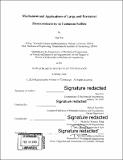Mechanism and Applications of large and persistent photoconductivity in cadmium sulfide
Author(s)
Yin, Han,Ph.D.Massachusetts Institute of Technology.
Download1196374072-MIT.pdf (14.63Mb)
Other Contributors
Massachusetts Institute of Technology. Department of Mechanical Engineering.
Advisor
Rafael Jaramillo.
Terms of use
Metadata
Show full item recordAbstract
Photoconductivity is the phenomenon where electrical conductivity changes as a result of photoexcitation of new charge carriers. In some semiconductors, photoconductivity is accompanied with enormous conductivity change and long decay time after photoexcitation is ceased. This effect is called large and persistent photoconductivity (LPPC). LPPC is due to the trapping of photo-generated minority carriers at crystal defects. Theory has suggested that anion vacancies in II-VI semiconductors are responsible for LPPC due to negative-U behavior, whereby two minority carriers become kinetically trapped by lattice relaxation following photo-excitation. By performing a detailed analysis of photoconductivity in CdS, we provide experimental support for this negative-U model. We also show that, by controlling sulfur deficiency in CdS, we can vary the photoconductivity of CdS films over nine orders of magnitude, and vary the LPPC characteristic decay time from seconds to 10⁴ seconds. Sulfur vacancies are deep donors at equilibrium in the dark, but convert to shallow donors in a metastable state under photoexcitation. We demonstrate two-terminal all-electrical thin film resistive switching devices that exploit this defect-level switching (DLS) mechanism as a new way to control conductivity. We introduce a hole injection layer to inject holes into the deep donor levels in CdS and switch CdS into a "photoconductive" state. The device is in low resistance state as fabricated, and shows repeatable resistance switching behavior under electrical bias with no electro-forming. Results from mechanism study rule out switching mechanisms based on mass transport and support our DLS hypothesis. LPPC is pronounced in n-type carrier-selective contact (CSC) materials in thin film solar cells, but its effect is rarely recognized. We numerically model the effect of LPPC in CSC by switching defect levels between deep and shallow donor states. CSC photoconductivity can substantially affect solar cell performance. For instance, the power conversion efficiency of both CIGS and CdTe solar cells can be improved by over 4% (absolute) depending on the photoconductivity of the CdS CSC. The primary underlying cause is the influence of CSC shallow donor density on the junction depletion region. Optimizing CSC photoconductivity may be effective in solar cell engineering across multiple platforms.
Description
Thesis: Ph. D., Massachusetts Institute of Technology, Department of Mechanical Engineering, 2020 Cataloged from PDF of thesis. Includes bibliographical references (pages 119-130).
Date issued
2020Department
Massachusetts Institute of Technology. Department of Mechanical EngineeringPublisher
Massachusetts Institute of Technology
Keywords
Mechanical Engineering.